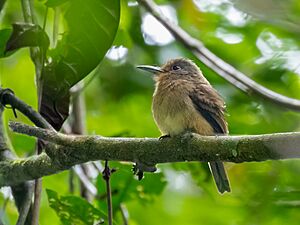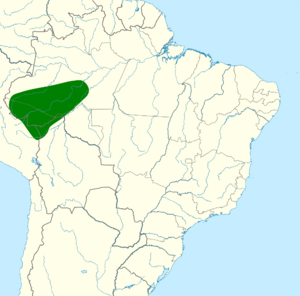Fulvous-chinned nunlet facts for kids
Quick facts for kids Fulvous-chinned nunlet |
|
|---|---|
 |
|
| Conservation status | |
| Scientific classification | |
| Genus: |
Nonnula
|
| Species: |
sclateri
|
 |
|
The fulvous-chinned nunlet (Nonnula sclateri) is a small, interesting bird. It belongs to a family of birds called Bucconidae, which includes puffbirds, nunlets, and nunbirds. You can find this bird in parts of Bolivia, Brazil, and Peru.
Contents
About the Fulvous-chinned Nunlet
The fulvous-chinned nunlet is a unique bird. It is the only species in its group, meaning it doesn't have any subspecies. Scientists believe it is closely related to the rusty-breasted nunlet and the brown nunlet. Sometimes, people even thought it was the same species as the brown nunlet!
What Does It Look Like?
This little bird is about 14 to 15.5 cm (5.5 to 6.1 in) long. That's about the length of a regular pencil!
- Its back, wings, and tail are a dull brown color.
- The area around its eyes (called the lores) is reddish-brown.
- Its cheeks are dark gray.
- The chin is a pale, yellowish-brown color, which is where it gets the name "fulvous-chinned."
- This color blends into a reddish-brown on its throat and chest.
- The middle of its belly is whitish, and its sides are a dull yellowish-brown.
- It has brown eyes with a thin ring around them that can be coral red or reddish-purple.
- Its upper beak is black, and its lower beak is dark gray or greenish-gray.
- Its feet are gray or olive-gray.
Where It Lives
The fulvous-chinned nunlet lives in the southwestern part of the Amazon rainforest. You can find it south of the Amazon River, from eastern Peru and northern Bolivia all the way to southwestern Brazil near the Madeira River.
This bird loves humid lowland forests. It usually stays in the lower parts of the forest, especially in areas that are not flooded. Sometimes, it can also be seen at the edges of forests that get flooded during certain seasons. It rarely lives higher than 300 m (980 ft) above sea level.
Behavior and Habits
What It Eats
Scientists don't know a lot about how the fulvous-chinned nunlet finds its food. However, they do know that it hunts from a perch, usually about 6 m (20 ft) off the ground. It probably flies out quickly to catch its prey. Its diet is also a bit of a mystery, but it most likely eats large arthropods, like insects or spiders. It might also eat very small vertebrates.
Reproduction and Life Cycle
Not much is known about how the fulvous-chinned nunlet breeds. It is thought that they might nest in a burrow in the ground. However, its close relative, the rusty-breasted nunlet, builds a shallow nest on sloping ground. This nest is covered with twigs and leaves. The rusty-breasted nunlet usually lays four eggs.
Its Song
The song of the fulvous-chinned nunlet is described as a "weak series of thin, mewing whistles." It sounds like wee weep weep weep weep weep.
Conservation Status
The IUCN (International Union for Conservation of Nature) has listed the fulvous-chinned nunlet as a species of "Least Concern." This means it's not currently in danger of disappearing. However, its exact population size is unknown, and it's believed that its numbers might be going down. It's rare across its large habitat, which makes it hard to count how many there are.
While there aren't specific threats identified for this bird, like all birds in the Amazon rainforest, it is at risk from habitat loss. This can happen due to many human activities, such as deforestation.


